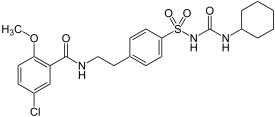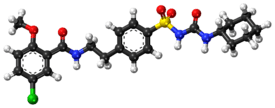Glibenclamide
 | |
 | |
| Systematic (IUPAC) name | |
|---|---|
|
5-chloro-N-[2-[4-(cyclohexylcarbamoylsulfamoyl) phenyl]ethyl]-2-methoxybenzamide | |
| Clinical data | |
| Trade names | Diabeta, Glynase, Micronase Daonil, Semi-Daonil, Euglucon, Delmide, Glybovin, Gilemal |
| AHFS/Drugs.com | International Drug Names |
| MedlinePlus | a684058 |
| Licence data | US FDA:link |
| Pregnancy category | |
| Legal status | |
| Routes of administration | Oral |
| Pharmacokinetic data | |
| Protein binding | Extensive |
| Metabolism | Hepatic hydroxylation (CYP2C9-mediated) |
| Biological half-life | 10 hours |
| Excretion | Renal and biliary |
| Identifiers | |
| CAS Number |
10238-21-8 |
| ATC code | A10BB01 |
| PubChem | CID 3488 |
| IUPHAR/BPS | 2414 |
| DrugBank |
DB01016 |
| ChemSpider |
3368 |
| UNII |
SX6K58TVWC |
| KEGG |
D00336 |
| ChEBI |
CHEBI:5441 |
| ChEMBL |
CHEMBL472 |
| Chemical data | |
| Formula | C23H28ClN3O5S |
| Molar mass | 494.004 g/mol |
| |
| |
| (verify) | |
Glibenclamide (AAN, BAN, INN), also known as glyburide (USAN), is an antidiabetic drug in a class of medications known as sulfonylureas, closely related to sulfonamide antibiotics. It was developed in 1966 in a cooperative study between Boehringer Mannheim (now part of Roche) and Hoechst (now part of Sanofi-Aventis).[1]
It is sold in doses of 1.25, 2.5, and 5 mg, under the trade names Diabeta, Glynase, and Micronase in the United States and Daonil, Semi-Daonil, and Euglucon in the United Kingdom, and Delmide, Glybovin in India. It is also sold in combination with metformin under the trade names Glucovance, Benimet, and Glibomet, as well as Glucored and Glucored Forte (by Sun Pharmaceutical) in Russia, Belarus and other countries of the CIS.
Medical uses
It is used in the treatment of type 2 diabetes. As of 2003, in the United States, it was the most popular sulfonylurea.[2]
It is not as good as either metformin or insulin in those who have gestational diabetes.[3]
Side effects and contraindications
This drug is a major cause of drug-induced hypoglycemia. The risk is increased against other sulfonylureas.[4] Cholestatic jaundice is noted.
Glibenclamide may be not recommended in those with G6PD deficiency, as it may cause acute haemolysis.[5]
Recently published data suggest glibenclamide is associated with significantly higher annual mortality when combined with metformin than other insulin-secreting medications, after correcting for other potentially confounding patient characteristics. The safety of this combination has been questioned.[6]
Mechanism of action
The drug works by binding to and inhibiting the ATP-sensitive potassium channels (KATP) inhibitory regulatory subunit sulfonylurea receptor 1 (SUR1) [7] in pancreatic beta cells. This inhibition causes cell membrane depolarization, opening voltage-dependent calcium channels. This results in an increase in intracellular calcium in the beta cell and subsequent stimulation of insulin release.
After a cerebral ischemic insult, the blood–brain barrier is broken and glibenclamide can reach the central nervous system. Glibenclamide has been shown to bind more efficiently to the ischemic hemisphere.[8] Moreover, under ischemic conditions SUR1, the regulatory subunit of the KATP- and the NCCa-ATP-channels, is expressed in neurons, astrocytes, oligodendrocytes, endothelial cells[9] and by reactive microglia.[8]
Analogs
Additional glibenclamide structural analogs have been prepared by Ahmadi et al.[10]
Research
Glibenclamide improves outcome in animal stroke models by preventing brain swelling[11] and enhancing neuroprotection.[7] A retrospective study showed, in type 2 diabetic patients already taking glyburide, NIH stroke scale scores on were improved on discharge compared to diabetic patients not taking glyburide.[12]
See also
References
- ↑ Marble A (1971). "Glibenclamide, a new sulphonylurea: whither oral hypoglycaemic agents?". Drugs 1 (2): 109–15. doi:10.2165/00003495-197101020-00001. PMID 4999930.
- ↑ Riddle MC (February 2003). "Editorial: sulfonylureas differ in effects on ischemic preconditioning--is it time to retire glyburide?". J. Clin. Endocrinol. Metab. 88 (2): 528–30. doi:10.1210/jc.2002-021971. PMID 12574174.
- ↑ Balsells, M; García-Patterson, A; Solà, I; Roqué, M; Gich, I; Corcoy, R (21 January 2015). "Glibenclamide, metformin, and insulin for the treatment of gestational diabetes: a systematic review and meta-analysis.". BMJ (Clinical research ed.) 350: h102. doi:10.1136/bmj.h102. PMID 25609400.
- ↑ Gangji, A. S.; Cukierman, T.; Gerstein, H. C.; Goldsmith, C. H.; Clase, C. M. (1 February 2007). "A Systematic Review and Meta-Analysis of Hypoglycemia and Cardiovascular Events: A comparison of glyburide with other secretagogues and with insulin". Diabetes Care 30 (2): 389–394. doi:10.2337/dc06-1789.
- ↑ Meloni G, Meloni T (January 1996). "Glyburide-induced acute haemolysis in a G6PD-deficient patient with NIDDM". Br. J. Haematol. 92 (1): 159–60. doi:10.1046/j.1365-2141.1996.275810.x. PMID 8562390.
- ↑ Monami M, Luzzi C, Lamanna C, Chiasserini V, Addante F, Desideri CM, Masotti G, Marchionni N, Mannucci E (2006). "Three-year mortality in diabetic patients treated with different combinations of insulin secretagogues and metformin". Diabetes Metab Res Rev 22 (6): 477–82. doi:10.1002/dmrr.642. PMID 16634115.
- 1 2 Serrano-Martín X, Payares G, Mendoza-León A (December 2006). "Glibenclamide, a blocker of K+(ATP) channels, shows antileishmanial activity in experimental murine cutaneous leishmaniasis". Antimicrob. Agents Chemother. 50 (12): 4214–6. doi:10.1128/AAC.00617-06. PMC 1693980. PMID 17015627.
- 1 2 Ortega FJ, Gimeno-Bayon J, Espinosa-Parrilla JF, Carrasco JL, Batlle M, Pugliese M, Mahy N, Rodríguez MJ (May 2012). "ATP-dependent potassium channel blockade strengthens microglial neuroprotection after hypoxia-ischemia in rats". Exp. Neurol. 235 (1): 282–96. doi:10.1016/j.expneurol.2012.02.010. PMID 22387180.
- ↑ Simard JM, Woo SK, Schwartzbauer GT, Gerzanich V (September 2012). "Sulfonylurea receptor 1 in central nervous system injury: a focused review". J. Cereb. Blood Flow Metab. 32 (9): 1699–717. doi:10.1038/jcbfm.2012.91. PMC 3434627. PMID 22714048.
- ↑ Ahmadi, A; Khalili, M; Khatami, K; Farsadrooh, M; Nahri-Niknafs, B (2014). "Synthesis and investigating hypoglycemic and hypolipidemic activities of some glibenclamide analogues in rats". Mini reviews in medicinal chemistry 14 (2): 208–13. PMID 24387708.
- ↑ Simard JM, Chen M, Tarasov KV, Bhatta S, Ivanova S, Melnitchenko L, Tsymbalyuk N, West GA, Gerzanich V (April 2006). "Newly expressed SUR1-regulated NC(Ca-ATP) channel mediates cerebral edema after ischemic stroke". Nat. Med. 12 (4): 433–40. doi:10.1038/nm1390. PMC 2740734. PMID 16550187.
- ↑ Kunte H, Schmidt S, Eliasziw M, del Zoppo GJ, Simard JM, Masuhr F, Weih M, Dirnagl U (September 2007). "Sulfonylureas improve outcome in patients with type 2 diabetes and acute ischemic stroke". Stroke 38 (9): 2526–30. doi:10.1161/STROKEAHA.107.482216. PMC 2742413. PMID 17673715.
| ||||||||||||||||||||||||||||||||||||||||||||||||||||||||||||||||||||||||